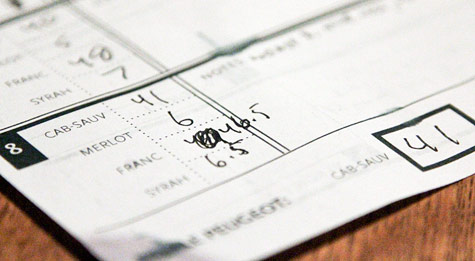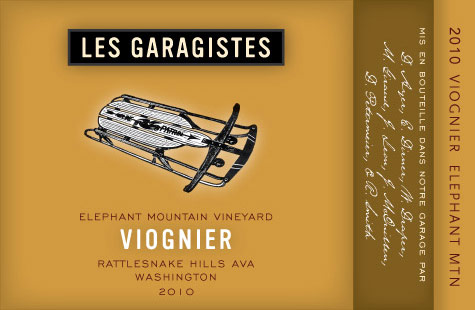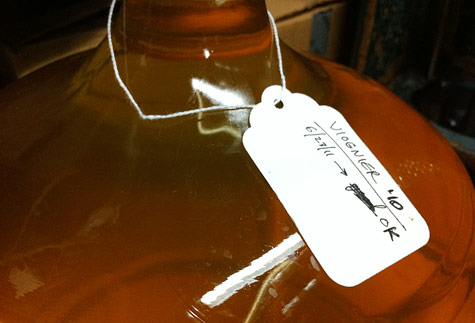Archive for August, 2011
2010 Peugeot Blending Trials: the components

After a disciplined night of ascetic, scientific rigor (and, uh, drinking), we have an official blend for our 2010 Peugeot. Here’s the thrill-packed, edge-of-your-seats story of how it all went down, in the two phases we went through it: assess the components, then concoct the blend.
Boy, does that sound like exciting reading or what?! Yeah? Okay, then: life insurance paid up? Great. Grab your micrometer and follow me…
The Components
As always, we began by tasting the components, beginning with the Cab Sauv. Still very young — definitely in need of one more racking — but firm and substantial. As I’ve noted before, this vintage gave us a huge gift of higher acidity, in this case putting all the complex flavors (black raspberry, dark cherries, even a hint of peach) into high-def.
From the first taste, it was clear the Merlot — never a huge component of the Peugeot — was destined for an even smaller role than normal. While the basic outlines of its Merlot-ness were fine, leaving it too long in new half barrel had rendered it way too woody to use in any quantity. Again, I think a hard racking will help, but this probably won’t be Merlot’s year to snatch the Oscar, that’s for sure.
Then the Franc. Always the defining cornerstone of the Peugeot, and this year, it’s absolutely fantastic. A lovely, floral (from stem to blossom) nose, beautiful and elegant in the mouth, lingering lovingly over a long finish. Again, the acidity of the vintage plays right into the Franc’s hand, balancing the depth of fruit we get from Elephant Mountain Vineyard with a vividness that takes you out of your glass and into a summer field in the Loire.
Lastly, the Syrah. We discovered that some of the ethyl acetate that’s apparently plagued a lot of winemakers this year (think fingernail polish) had snuck back into the Syrah, so we’ll be carpet bombing this sucker with sulfite, and stat. But after the EA blew off, the wine’s true nature unfurled, with lovely deep fruit and a hint of licorice. Last year was the first time we added Syrah into the Peug, so provided we can 86 the EA, it’ll definitely have a cameo this year, too.
Next, the scintillating blending trials themselves…
No commentsViognier? Safely in bottle.
ikoni Eight cases plus eight bottles. 3.06 pH (hey, at least it’s better than 3.01, which it was a couple of weeks ago) — vivid! Lovely, floral nose, though probably goom-bah’d by a little too much oak at the moment. 25ppm sulfite at bottling. We’ll let it sleep until next summer and hope it unfurls.
Eight cases plus eight bottles. 3.06 pH (hey, at least it’s better than 3.01, which it was a couple of weeks ago) — vivid! Lovely, floral nose, though probably goom-bah’d by a little too much oak at the moment. 25ppm sulfite at bottling. We’ll let it sleep until next summer and hope it unfurls.
Update 2010: The Troubled Ones II
 Our Viognier may yet have a Hollywood ending. Our Rosé, well… by any other name, would taste as sweet…
Our Viognier may yet have a Hollywood ending. Our Rosé, well… by any other name, would taste as sweet…
Rosé
Our Rosé was a tank bleed (or “seignée”) of the Grenache right after it was crushed. I confess this one totally drank my lunch, tossing a number of problems at me I had no answers for. The biggest was thinking I was watching a nice, slow fermentation through the fall, then winter… then spring… when in fact primary fermentation had collapsed short of the goal and what I was actually seeing was malolactic fermentation (a secondary, bacteriological fermentation that changes malic acid into lactic acid). As a result, I didn’t realize this wine was “stuck” — not completely fermented and stalled in a sticky, quasi-alcoholic stasis — until a month or so ago.
Restarting a stuck ferment is notoriously hard, because you’re asking the yeast to start from a dead stop in an environment mostly toxic with alcohol (again, the ferment has nearly converted all the sugar to alcohol at this point, so the wine is pretty poisonous stuff as far as yeast is concerned). So I went through the laborious and time-consuming protocol recommended by the good folks at Scott Labs. It involves multiple nutrient additions over the course of a few days, then gradually adding waves of yeast over the course of an afternoon so they methodically gain confidence and territory without freaking out. In extreme cases, the protocol also calls for standing on one foot, baying at the moon, and whacking yourself with a switch.
Okay, those last three aren’t exactly in Scott Labs’ protocol, but I do think they helped in this case. One of the carboys actually finished, so now we need to decide if we should just blend the two together (the other is about 1% residual sugar), filter it, and call it a lesson learned; or figure out how to get the other one to finish.
Frankly, I’m ready to clear the decks, if only because the last thing I want to be doing in September as grapes arrive is pleading with a grumpy rosé. So I think we’ll probably just bottle it in the dark of some night and walk away, whistling innocently. It does still smell pretty decent behind all the yeast, so if we filter then blend the 1% and the nearly-none-percent carboys, we’ll have a wine that may be a tad sweet, but with luck, come off as “fruity” when chilled into restraint.
Here’s hoping…
No commentsUpdate 2010: The Troubled Ones
 … and at last we come to the wines that haven’t exactly breezed through our underground lair. Not to say they might not be lovely some day, but for now: curse you, Bacchus!
… and at last we come to the wines that haven’t exactly breezed through our underground lair. Not to say they might not be lovely some day, but for now: curse you, Bacchus!
Today, our Viognier; next, the Rosé. Hmmm: they’re both white (or white-ish) wines. Just a coincidence, you say? Ah, gentle reader, that’s why we love you…
Viognier
This is our first year with this varietal, and we unwittingly made a huge tactical error right out of the gate: we didn’t have a herky enough press to really extract everything from this notoriously thick-skinned grape. That meant a much smaller yield than was our due, but it’s probably also why our wine is so acidic — just a hair over 3.0 pH: we’re working with just juice, not the (I’m guessing) riper compounds in the grape skins that resisted our press’ embrace.
So it’s a bit on the… refreshing side. “Crisp,” one might say. A “food wine,” as the wine industry spins its more bracing effluent. Maybe even: that “mom’s secret to whiter teeth” you’ve seen manically waving its hand in the back row of every web site, urging you to call on it.
Okay, enough ganging up on our gaunt Viognier. In its defense, it does still smell utterly lovely (peaches, pears, spice) — and the acidity is likely to preserve that nicely until its infrastructure begins to soften. So with luck, it’ll simply be a wine we’ll want to lay down for a year or so before enjoying.
And we haven’t just let it sit there, shivering in its acidity. To balance the low pH with more flavor and dimension, we’ve kept it on its lees, which we’ve been stirring once a week or so. That was an invaluable tip we got from Riesling specialist and all-around brilliant winemaker Matt Berson, of Love and Squalor Wines, and it really seems to have helped.
And not content to leave barely-well-enough alone, I also thought I’d try one last gambit to offset this wine’s high pitch: I added a touch of oak. Not much, and not for long, but yeah, maybe I do have some kind of death wish where whites are concerned. The idea was to add just enough to add some depth, but not enough to oak it into chardonnay — a fate worse than… brrrr, let’s change the subject!
But after just two weeks, I pulled a sample and — Yellow my Tail! — oak vanillin already seemed to have plowed over the fragrance! I immediately yanked it off the oak and the lees, and I’ve let it sit quietly to calm itself after its brief stroll walking the streets.
Then, this morning, I thiefed a sample: time to face the music. How badly had I F’d it up? But hmmm, you know what? The oak does seem to have descended into the wine, leaving the lovely Viognier fragrance intact but adding a bit of flesh to the wine — despite its still-bracing acidity. I’d been thinking we should fine this before bottling, but maybe we ought to let whatever particulate is still there continue its broadening effect and then just decant if there’s significant settling in the bottle.
Dare I say it? The yay may well be back in our Viognier! Time will tell…
No comments
